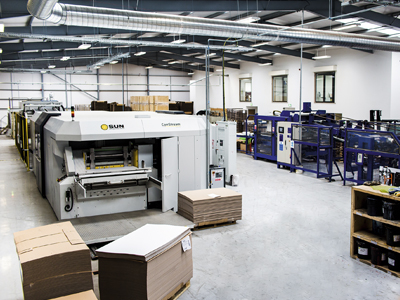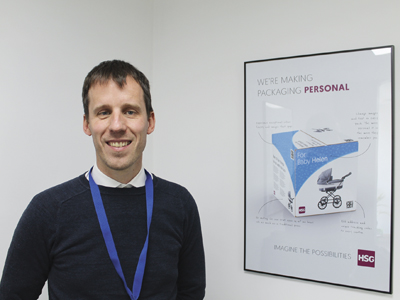Ben Ginesi, managing director of HSG Packaging
HSG Packaging has worked closely with Sun Automation over the past few years to put the dream of a digital single-pass corrugated press into reality. Neel Madsen went to Bradford to hear how the company is introducing digital industrial production.
When managing director of HSG Packaging, Ben Ginesi, first started investigating digital print for corrugated quite a few years ago, there were not many options on the market; not when the vision was to implement single-pass printing on an industrial scale. Flatbed and multi-pass systems simply could not meet the demand for higher output that was slowly growing from HSG’s existing customers, so in early 2016, the company installed a CorrStream 66 digital printer from Sun Automation.
‘Product diversification has always been a key strategy for us,’ said Mr Ginesi. ‘We have a good track record of establishing products before they become mainstream. We knew that if we could have volume digital production, we could look to create a space that didn’t exist in
the market.’
Education phase
Making the business model work is one of the biggest stumbling blocks for the adoption of digital print for corrugated. Translating digital into corrugated presents different challenges compared to other print sectors; what works in labels, may not work in this sector.
‘We wanted to widen the area of consumer choice in respect of what they do with their packaging,’ explained Mr Ginesi. ‘As an industry, we have spent many years managing customer expectation, be it on volume, tooling costs or origination. Our dream is that the customer will pay one price for the box, but ostensibly can order any quantity.’ He continued, ‘Digital can offer that in corrugated, but a lot of education is needed first. This is the phase we are going through now; allowing customers to understand what is possible.’ He acknowledged that this will be a long process and that the industry will not change overnight, but that slowly the market is being driven towards digital solutions.
Other barriers to adoption include the established supply chain. While for instance a personalised box can easily be produced for a consumer, getting that successfully through fulfilment at a major retailer, so that the right product ends up in the right box, is a challenge. Most warehouses and distribution centres are simply not set up to handle this type of packaging. Mr Ginesi commented, ‘The education phase goes beyond the customers. We are talking about complete integration between supplier and customer.’
Describing the supply chain as part of an ‘ecosystem’, he explained, ‘The complexity when we talk about the ecosystem of digital printing for corrugated is that it requires, more than anything else we’ve had, an interaction between customer and supplier to work through all the potential challenges; you need people to go on the journey with you. Half the challenge is the hardware; the other half is everything that sits around the hardware.’ In house the same applies, everyone has to buy into the new system to understand it.
Sean Moloney, global product manager digital at Sun Automation, commented, ‘I’ve known Ben for quite a few years now and we have had the same vision for a long time. It has been a fantastic journey getting to this point and we are now working on fleshing out the concepts. Ben has a great grasp of the technology and understands the need to build the ecosystem around the printer.’
Transparency
Founded in 1978 by Ben’s father Harold Ginesi, HSG originally specialised in wooden packing cases and other timber products, but since the early 1980s, its main business has been in corrugated packaging. This was also the time that the company relocated from Brighouse to its current site in Low Moor in Bradford. Over the next 20-25 years, the company developed with the market, buying newer, faster machinery capable of producing a full range of packaging. Mr Ginesi explained, ‘When we got into corrugated, we didn’t want to produce just one product, but a range of boxes, for a diverse client base.’ The print technology was flexo, but around 2007, HSG diversified into litho-laminate technology.
Then, in 2010, the idea of digital took hold as customers were increasingly introducing multiple SKUs (one brand client had over 40 SKUs); jobs for the same client could vary from just 20 boxes with one design each year to 200,000 of another, and anything in between. With the cost of setting up, producing these small jobs on the litho-lam line was not cost-effective, and the company started to look for a solution.
In 2012, a new modern facility was completed at Low Moor, and today the Scandi-looking factory houses 45 staff and turns over £4.5 million producing both digital and conventionally printed corrugated products. The open design of the building with glass-partitioned offices and large panoramic windows looking out over the factory floor, where the CorrStream 66 press stands, reflects company ethos. ‘You have to be transparent and honest with your customers,’ said Mr Ginesi. ‘When we talk to them about digital, we explain not only what the system can do, but also what it can’t do. Once they understand the process, they have to decide for themselves how it can work for them. There is no point in us forcing the issue.’
Common vision
When HSG first came across US-based Sun Automation, the digital printers were in the early stages of development, but Mr Ginesi liked the company ethos which he said is based around the benefits they can bring to customers. He explained, ‘We had a common vision; we didn’t agree on everything, but we had the same goal. We would listen to our customers, find out what they might want from digital and feed that information back to Sun. This all helped to refine the project as we went along.’

The CorrStream 66 press at HSG’s facility in Bradford
The machine installed at HSG is the CorrStream 66 – the flagship model in Sun Automation’s range of modular corrugated printers for industrial production. Printing at widths up to 1345 mm on 1600mm wide board, the inkjet machine uses food safe, water-based inks in CMYK and printheads with five grey scales to reproduce up to 80% of the Pantone colours (a number Sun is working to push even higher). The press can print 8000 sheets per hour, which is equivalent to a running speed of over 70m/min.
One important feature of the press is Sun’s proprietary lead-edge feeding technology, which offers stable board handling of thinner board and less waste caused by jams. Set up can be performed in less than three minutes and requires just four touches from the operator before the machine is up and running.
Into the future
Having spent over a year refining the business model, digital print runs up to 10,000 are viable for HSG, said Mr Ginesi. ‘We now have a realistic value proposition that works for both customers and manufacturers; we understand the relationship between costs and features, and we are ready for the next phase.’
‘Digital will be the future for corrugated; it will be mass market – you just have to look at the benefits,’ he said. ‘But it requires a much more flexible mindset and we have learnt a lot along the way; we had to redefine our thinking. I’m not saying we have now got everything right; we will continue to evolve with the technology as we both develop.’






